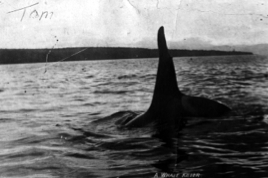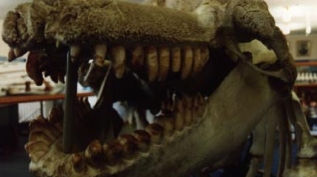
Old Tom “The Humourist”
Tom off South Head and leatherjacket bay swimming right to left.
His dorsal fin has a small knob on its trailing edge and a bend to his right.
Tom’s jaws showing bottom teeth worn to the gum line and a distinctive groove worn
into his tooth on his lower left . Hold your mouse over both images for more detail.
Old Tom is the most famous of the Eden killer whales. He was easily recognised
by his tall and distinctive dorsal fin.
He was a male orca 22 ft long with a dorsal fin 5’ 8” high. His short length compared to Orcas in other seas may simply have been due to his hardy lifestyle. The size and shape of his dorsal fin and
photographs of his genitalia confirm he was male. Tom passed away in 1930 and
floated into Snug cove in Twofold Bay. The Davidsons estimated that he was over
70 years old and perhaps as old as 80 or 90. It is unknown if southern
hemisphere orca lifespans differ from northern groups.
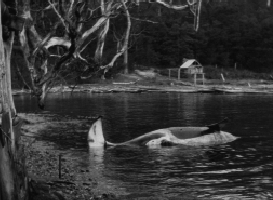

J.R. Logan, the Davidson’s neighbour suggested Tom’s Skeleton be preserved by George and his son Wallace and Logan funded the
construction of a museum to house him.
His preserved skeleton still now resides at the Eden Killer Whale Museum yet he
was the best known and best loved of the killers even when he was still alive.
He was not necessarily the leader of the Eden pod but was regularly one of the
members of the pod assigned to swim to the mouth of the kiah river and “flop-tail” to alert the human whalers to the presence of a whale under attack. As his
regular task was to contact humans, he became one of the most favoured by the
whalers and perhaps developed� the strongest relationship with humans as a
result of his regular contact.
Tom was known as “the humourist” for his sometimes amusing, and sometimes annoying antics.
He would often jump on top of a rope fastened to a harpooned whale and hang on to it to be towed around
like a sea anchor. Some of the old whalers described him using his pectoral
fins to hang onto ropes and others describe him using his teeth.
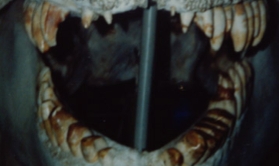
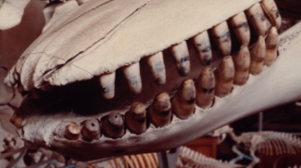
Tom’s teeth with distinctive “rope” groove on tooth on lower jaw.
Mediteranean Orca skull from Monaco with severe wear but no deep grooves as seen
on Tom’s tooth
In the “Killers in Eden” documentary Danielle refers to other orca skulls, specifically the monaco
skull, as having the same pattern of tooth wear as Tom’s skull but on close inspection that proves not to be the case. The Monaco skull
shows plenty of wear but has no feature at all resembling the deeply worn “rope” groove of Tom’s lower left tooth. If anyone can find an image of an orca skull with a smoothly worn groove similar to Tom’s then please contact the author at greg@mckeewildthings.com
Eden Fisherman Jackie Warren described in a video interview how Tom would grab the anchor line of Jack’s fishing boat from the sea bottom and tow him around for fun.
J.R. Logan’s daughter Margaret Brooks describes being on her father’s motor yacht towing a dead whale and Tom trying to stop the boat by holding the
tow rope in his mouth. The teeth missing from the right hand side of his upper
jaw were possibly lost as a result of this struggle.
Perhaps most extraordinary, a journal from the turn of the century describes: “Davidson threw a painter(anchor rope) over the bow of his boat. It was
immediately grasped by two killers. They took the rope tandem fashion with a
half hitch around the shoulder and started for the quarry, overtaking the
opposition. They had in their mouths 60 fathoms of 2 inch coir rope.”
The stories of the killers actually towing the whaleboats out to a chase have
been discouraged by the Davidsons in the fear that they might seem so fanciful
to outsiders that they would throw doubt on other stories. Knowedge gained from captive cetaceans show that towing boats around is well
within their capabilities and intellect . Aquarium performances regularly
display small boats being towed around by dolphins.
On a number of occasions, Tom had swum around members of the boat crews who had
been tipped overboard in accidents. The crews believed the orcas were
protecting them from the large numbers of sharks that would follow the chases.
The Davidsons were very fond of Tom and described him as “part of the family”.
For decades almost all aspects of the Eden story were treated with derision by
uninformed skeptics.
The idea that the killers would not attack the humans was believed nonsensical
as even 1970s US Navy diving manuals stated that orcas are ferocious and will
attack and eat humans at every opportunity. In fact no human has ever been
attacked and killed by a wild orca. Some historians claimed that Old Tom was a
female, despite conclusive photographs to the contrary of his dorsal fin and
genitalia, and the idea that Orcas could be recognised by sight and given names
was ridiculed, even though it is now standard scientific practice for
identifying individual wild orcas.
Fortunately, in support of the Eden story, modern science has revealed that
orcas are intelligent creatures with astonishing accoustic senses, social
coordination, self awareness and culture, able to learn rapidly, innovate,
manipulate objects, and can be willing to interact with humans.
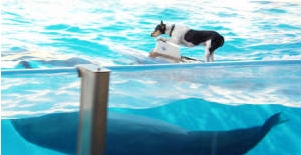
Are cetaceans capable of towing vessels?
What do your eyes tell you here?
Whilst it may seem fanciful, acounts of the Eden killers towing boats are
certainly within the physical capability of orcas. Wild orcas are not averse to
pulling on the ropes of fishing nets as many professional fishermen will
attest. No photographs of the eden orcas exhibiting towing behaviour have yet surfaced
to date.
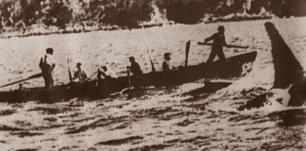
Tom and George in action in a still from the 1910 documentary film “Whalechase in Twofold Bay”.
The 35mm film was produced by “The Twofold Bay whalechase biograph syndicate”, namely C.E. Wellings and C.B. Jenkins .

Tom leading a whaleboat and heading off a Humpback whale. The distinctive
trailing edge of his dorsal fin noticeable.
The stories of Tom are not the result of foggy memories of a single event but
the regular working day reality over decades for a family of whalers and their
crews,

A Humpback at kiah tryworks in 1908 with lips and tongue missing. There has been
no processing carried out on the whale. The killers having taken their first
share exactly as described by the “law of the tongue”.










